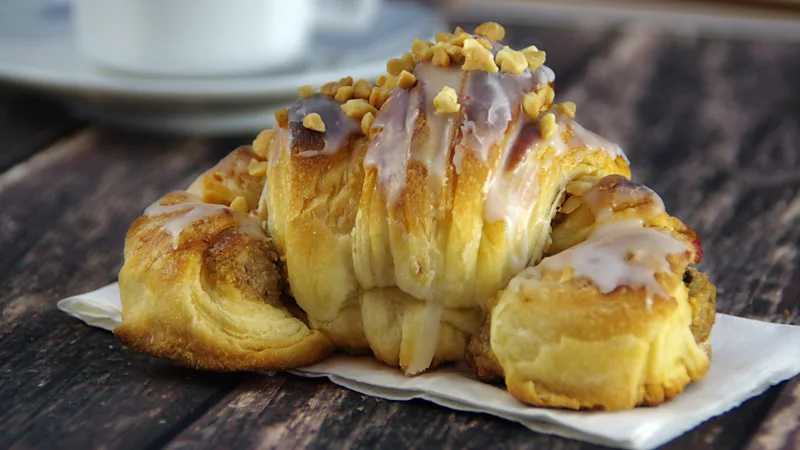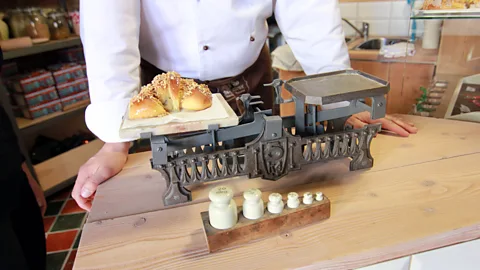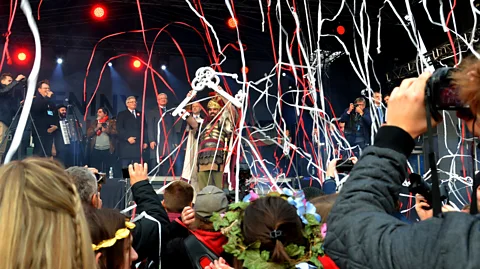An epic croissant that’s the star of a Polish parade

The flaky, buttery, layered croissant is irrevocably tied to France, its country of origin. But every 11 November, on the Feast of St Martin, the Renaissance-era city of Poznań in western Poland comes alive with an extravaganza starring a very special horseshoe-shaped pastry; the Rogale swiętomarciński, or St Martin’s croissant.
While the rest of the country celebrates Poland’s Independence from Prussian, Austrian and Russian occupation, waves of entertainers ranging from stilt-walkers to pom-pom-waving cheerleaders march through Poznań’s streets for the St Martin’s Day Parade. Around 1.25 million St Martin’s croissants are consumed on that day alone – equating to about 250 tonnes of pastry.
This sweet treat’s saintly origins go back to the 19th Century when a local priest encouraged his congregation to help the poor in the spirit of St Martin, who famously cut his cloak in half to share with a beggar. A local baker named Józef Melzer is credited with the idea of honouring the pious act by creating a pastry when he prayed to St Martin and dreamed that a white horse entered Poznań and lost its golden shoe. The next day, he made horseshoe-shaped croissants to give to the city’s poor, and the tradition quickly spread as more bakers joined in. Over the years, the delicious treat evolved into a regional speciality.
Despite the physical resemblance and the similar name – rogale means croissant in Polish – the St Martin’s croissant is distinct from the classic French pastry. Poznań’s version is topped with sugar and nuts, and the flaky pastry layers ooze with a thick, luxurious filling made of white poppy seeds, nuts, raisins, almonds, sugar and butter. Each croissant weighs around 250g and comes in at belly-busting 1,200 calories. Sold by weight, the croissants are priced between 15-20 zloty (£2.90-£3.80) per pastry, reflecting the time and effort put into creating this legendary food.
 Poznań Local Tourism Organisation
Poznań Local Tourism OrganisationAround three million St Martin’s croissants are sold each year in Poznań, and it is taken so seriously in this part of western Poland that in 2008 it the croissant was given Protected Geographical Indication (PGI) status by the European Union, joining Gouda cheese from Holland and handcrafted Dresdner Christstollen from Germany, as well as another Polish speciality: the kiełbasa biała parzona, a white sausage from the region of Wielkopolska.
This ruling means that only certified bakeries in Poznań are allowed to produce these croissants under the official name. They must also follow strict guidelines to ensure the quality is upheld and apply annually for certification.
Each baker applying for a certificate must make 24 croissants, which are tested to ensure they follow the exact ingredients and method, which includes folding the dough to create the required 81 layers before the filling can be added. The entire process can take up to six hours, with 35 minutes left between each turn to allow the dough to breathe. This year, just 84 bakeries were given certification by the Chapter of the Traditional Rogal Swietomarcinski.
Production goes into overdrive in November, with tonnes of ingredients brought in to accommodate the city gobbling up more than a million croissants on parade day.
One of the Poznań’s busiest bakers is Hanna Piskorska, who has six shops in the city and her products are so popular she also sells them online across the world. “On 11 November, we are literally besieged with people, which shows the great trust people have in our croissants,” said Piskorska.
 Jakub Pindych
Jakub PindychOn St Martin’s Day, the entire city stops to celebrate the saint and its beloved croissant. The thunderous procession starts at St Martin’s Church (step inside to see a carving of the saint slicing off a swathe of his cape to pass to a cold and hungry beggar) and continues along St Martin’s Street, ending after a nine-minute walk to the Imperial Castle, an impressive monument constructed under German rule in 1910.
Learn more
Not in town on 11 November for the St Martin’s Day Parade? Poznan has a Croissant Museum which offers a fun, hands on introduction to the pastry and its history. Celebrating its 10th birthday this year, the museum has workshops in English and Polish where visitors can try their hand at making a croissant; the one judged to be best is cooked and presented to the maker to eat.
At the forefront of the procession is St Martin on a white horse, portrayed by an actor in colourful historical costume. Around him are locals in traditional 18th-Century Bamberg dress – first brought to Poznań by German immigrants – with women donning long, flowing colourful clothes and hats made from flowers. People carry baskets of croissants through the crowds lining the streets to make sure no one goes hungry, and there’s even a croissant fair where the 84 approved bakers sell their pastries so people can taste them all and pick their favourites.
“Traditionally, at the end of the parade, the Mayor of Poznań ceremonially hands over the keys to the city to St Martin, symbolising his authority for the day,” said Weronika Duszak from the Croissant Museum. “The day is a public holiday, meant to be spent with family and friends, rejoicing over shared croissants, music and festivities.”
 Poznań Local Tourism Organisation
Poznań Local Tourism Organisation




